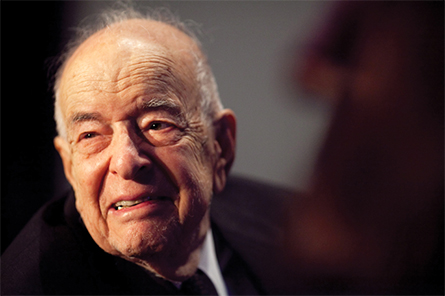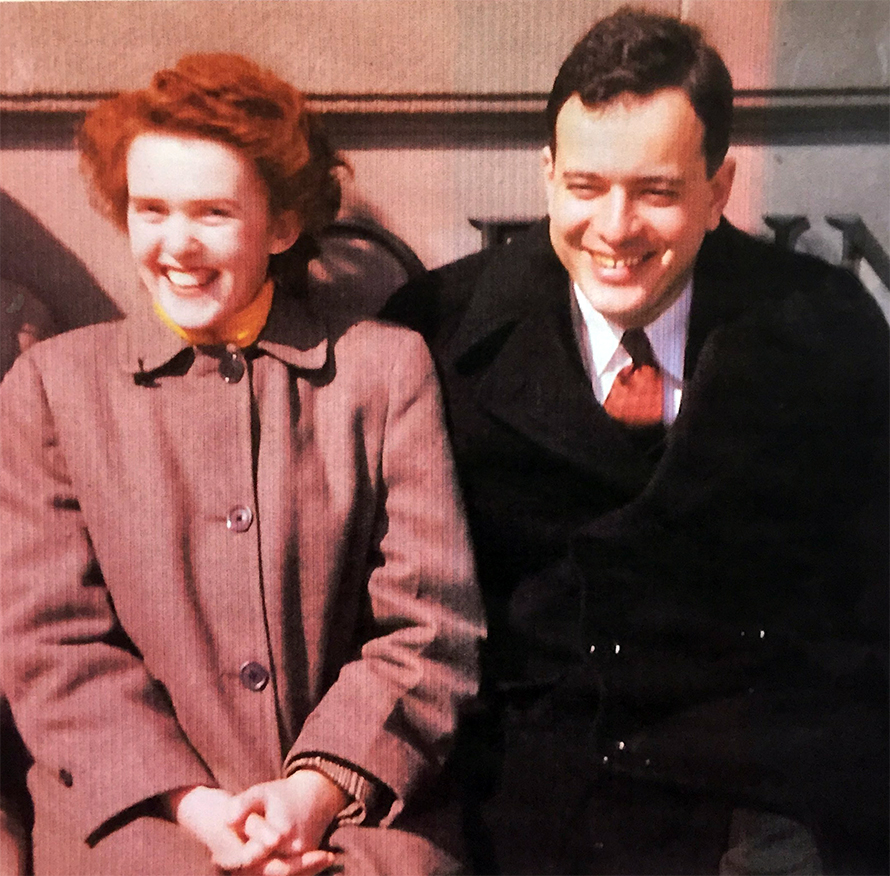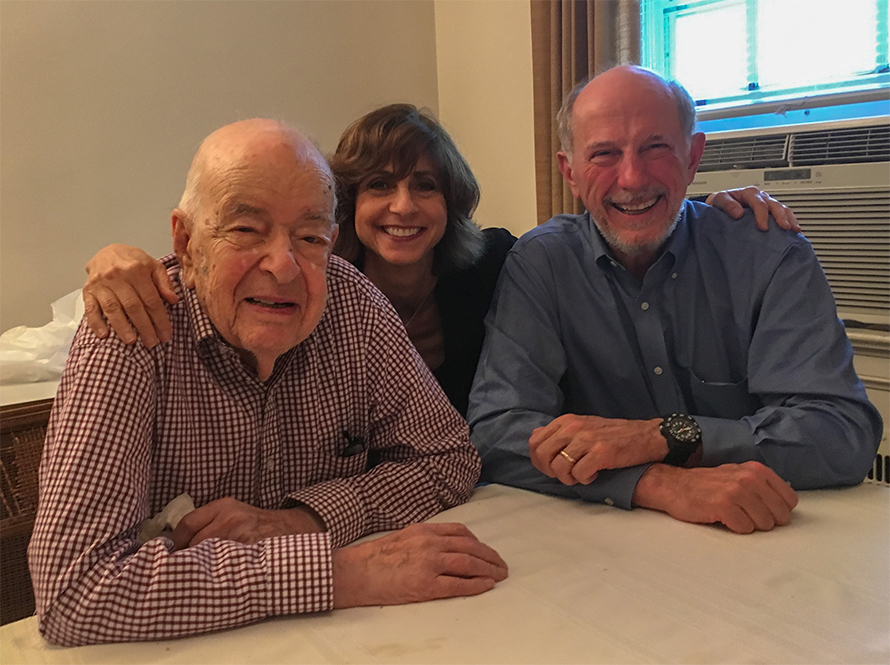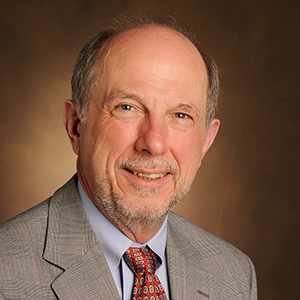Herbert Tabor (1918 – 2020)
On Aug. 20, the biochemistry community lost one of its giants with the passing of Herb Tabor at the age of 101. Herb was a unique individual, and he definitely will be missed.

Others knew him better than I did, but he outlived most of his contemporaries, so I was asked to write this Retrospective. I met Herb at a Journal of Biological Chemistry editorial board meeting when I joined the board for the first time in 1984, and we became acquainted later during my time on the American Society for Biochemistry and Molecular Biology council. I got to know him better after 2006, when I became an associate editor at JBC.
Herb was one of the finest individuals I have known in this field. Several obituaries already have appeared, and a detailed autobiographical account of Herb and his late wife, Celia, appeared in the 1999 Annual Review of Biochemistry. I will try not to repeat too many things. I will write about my experiences with Herb and what I know about him.
Herbert Tabor was born in New York City on Nov. 28, 1918, which he told me was Thanksgiving Day that year. World War I had just ended, and there was a viral pandemic then too. I do not know much about his childhood, but obviously, he was a real prodigy, attending the City College of New York for two years and then Harvard College, graduating from Harvard at the age of 18. He obtained an M.D. from Harvard Medical School at the ripe old age of 22 in 1941.
During his last year of medical school, Herb worked in the lab of A. Baird Hastings and developed his passion for research. His first paper in JBC was published in 1943 on this work, measuring the ionization constant of magnesium phosphate. His last JBC paper (which I acted as associate editor for) was published in 2015, 72 years after his first. I doubt this record ever will be eclipsed.
Herb’s medical degree did not lead to a long clinical career, but while an intern at Yale in 1942, he was the first individual to inject a new antibiotic called penicillin into a patient. The patient’s recovery from severe streptococcal septicemia was remarkable, and this and other successes led to the scaling up of fermentation and use of the drug in the war effort. Herb also spent time during World War II as the only medical officer on a U.S. Coast Guard cutter ship, part of convoys in the North Atlantic. Despite a scare or two, he said, he did not have to do any surgeries.
In 1943, Herb was transferred to the U.S. Public Health Service, at first working under the direction of Sanford Rosenthal, beginning his 77-year career at the National Institutes of Health. He became a lab chief and continued in that role until 1999, when he was succeeded by Reed Wickner, who had trained with him. In the early 1940s, the NIH was new, and the NIH intramural program was small, located in Bethesda, Maryland. There, Herb and Celia Tabor began their pioneering research on polyamines, a topic that is still very interesting and was featured in a special collection in JBC edited by Tony Pegg to celebrate Herb’s 100th birthday.
In the early days at the NIH, a group of what were to become stellar scientists would meet to eat lunch daily over presentations and lively discussions of current literature in the growing field of biochemistry. The group included Herb Tabor, Arthur Kornberg, Leon Heppel, Bernard Horecker, and later others such as Earl and Thressa Stadtman, Christian Anfinsen, Alton Meister, Osamu Hayaishi and Bruce Ames. I would have loved to be part of that exciting time. Today, our field, in part because of its success, has become so broad that it is difficult if not impossible for an individual scientist to follow everything in any detail.
Herb and Celia were essentially free of most administrative responsibilities at the NIH. There was no grant writing, teaching, attending faculty meetings or serving on committees, and they relished this. Herb routinely did much of his own lab work. Late in his life, at one of our JBC associate editors’ meetings, some editors were comparing problems with their eyeglasses. Herb said he was having problems in the lab with his own glasses when he was transferring bacteria, which meant he was doing the work himself. I also recall an account (not from Herb) of an NIH investigator in the 1980s who went to Herb’s office to complain about a JBC submission that had been declined. He wound up having to follow Herb all around the lab because Herb was in the middle of some work, transferring rotors. The author finally felt embarrassed about bothering him.

Herb and his family lived at the NIH starting in 1949 in one of the duplexes built for staff. The big advantage was the ease of getting to and from work. Herb told me he used to walk home for breakfast (presumably, he went to the lab early). He lived in the same house at the NIH until his death. Living on the NIH campus is not so attractive today due to the security checks needed to enter; trust me — it’s like the airport.
Herb was elected to the U.S. National Academy of Sciences in 1977, and in 1995, Herb and Celia received the ASBMB William C. Rose Award. I was asked to provide comments on his research program for an NIH intramural review. That was a humbling experience — how could I critique this great man? I was asked how his success compared with his contemporaries, but he had outlasted all of them.
In 1961, Herb joined the editorial board of JBC, and he became an associate editor in 1969. By today’s standards, JBC was still a small enterprise, although it was certainly a premier journal in the field. When Bill Stein developed health issues, Herb took over as acting editor-in-chief and then as editor-in-chief in 1971, a job he would hold until 2010.
If you knew Herb, you could only be impressed by his organizational skills, his work ethic and his dedication to fairness. During his nearly 40-year tenure as editor-in-chief, JBC grew tremendously. Herb assigned all of the manuscripts out for review by himself, with the average rising to more than 50 per day at the peak of our submissions. In line with what he construed was his obligation to his job at the NIH, he did none of this during the workday — and it was much harder to do the necessary editorial work in the pre-electronic era. Assistants from the JBC office would leave a big sack of paper manuscripts at the back door of his house every evening. Sometimes, he would use the pay phone at the NIH lab to call the JBC office (during his lunch break), have titles read to him and make assignments (an early effort at e-communication). He handled complaints from authors and manuscript controversies on the weekends. In addition, he hosted three associate editor meetings each year.
As JBC grew, in the late 1980s, we heard pessimistic forecasts at our editorial board meetings regarding whether we could ever deal with the growing page volume. The JBC did not make too many mistakes during Herb’s tenure, but one was the attempt at “miniprint” (go back to some 1980s JBC papers if you are too young to remember that). The issue later was resolved by instituting electronic publishing, where JBC led the field. Although Herb was no longer a young man, he adapted well to the electronic systems with his Mac and really pushed this new venture. As an associate editor, I knew that my new assignments (now electronic) would start rolling out every evening at about 6 p.m. Eastern time, when Herb got home from work. Even through the heavy submission years, Herb was a hands-on editor, and he assigned papers to himself for review as well as to the associate editors. He did delegate aspects of the JBC operations to Barbara Gordon and later to Nancy Rodnan, the ASBMB publications directors, both of whom he greatly admired. However, Herb was a nuts-and-bolts guy who drove the journal.
Herb worked well with the associate editors. He invited our input and was supportive in any problems we encountered dealing with authors, although he certainly wanted to be fair to the authors too. At the associate editors’ meetings, he let us all have our input but was able to reach a consensus and then to make us all feel that we had been part of his final decision (“I think you will all agree with me that …”).
As he indicated in his Annual Review of Biochemistry article, his objective for JBC was not to restrict publication to the most exciting research areas; we had a policy of accepting all manuscripts that made a substantial biochemical contribution. That is, we wanted to publish exciting papers but not at the expense of solid contributions that are important for the development of science. He resisted pressure to allow exceptions to our policy of considering all manuscripts equally, without any preselection or commitment for expedited publication of favorite authors or subjects. Some JBC Classics papers, for example, might not have seemed exciting when published, but they stood the test of time and had great impact.

After retiring as editor-in-chief, Herb continued with the title of co-editor and was helping assign manuscripts even after his 100th birthday. We sometimes would talk about assignments of problematic manuscripts or whether a submitted paper really fit our journal best — his instincts were almost always right. I never have heard anyone say anything bad about Herb, although there must have been some complaints; when you are an editor, you cannot accept all the papers, and he must have annoyed someone along the way. Publishing is changing rapidly today, and I doubt if any editor will ever match the 40-plus years Herb ran JBC.
I was privileged to know and work with Herb Tabor. He was in essence a humble man. Beyond his family, he focused everything on science and JBC. The ASBMB and the entire biomedical science community will miss him. Herb was truly a person to emulate. The ASBMB already has recognized him with the Herbert Tabor Research Award for excellence in biological chemistry and molecular biology and contributions to the community of scientists and the JBC Herbert Tabor Early Career Investigator Awards given to first authors of exceptional JBC papers.
Herb was preceded in death by his wife, Celia White Tabor, in 2012. He is survived by his four children, Edward, Marilyn, Richard and Stanley, as well as 10 grandchildren and six great-grandchildren.
So long, Herb. You are really missed. Thanks for the memories, on behalf of all of your admirers.
REMEMBRANCES
I was very fortunate to be a postdoc down the hall from Herb from 1989 to 1995. I warmly recall Herb and Celia eating lunch during our weekly seminar series. She would open up their lunch bag, hand him half a sandwich and take the other half. When that was finished, she would then take out a piece of fruit, cut it in half and give him his half. It was so wonderful to see their love for one another. And fortunately, one of his postdocs, David Balasundaram, and I cooked up a collaboration that ended up as a couple of papers. To be a co-author with Herb was a great honor. Herb always had an open door and an open ear, and he asked the best questions. He was a force of nature.
— Jonathan D. Dinman, University of Maryland
After our first publication on a key enzyme in polyamine biosynthesis, Herb was among those whose comments encouraged me to shift much emphasis in my lab toward the study of polyamines. In the subsequent 10 years, I met many good friends and colleagues at stimulating and entertaining meetings in the U.S., Europe, Japan and Israel. Eventually, mitochondria regained my attention. Thus, I have not seen many of my “polyamigos” for some time, but I retain wonderful memories. Herb stands out among them as a giant role model in research and service to science.
Herb also was responsible for my selection to the editorial board of the JBC. The 10 years I spent on the board were challenging but most rewarding and satisfying.
— Immo Scheffler, University of California, San Diego
In the fall of 2009, Herb Tabor phoned to ask if I would write the National Academy of Sciences biographical memoir of the biochemist Mahlon Hoagland (1921–2009). I think he was doing so as chair of NAS Section 21 at the time. He quickly added, “You are in a unique position to do this.” Sensing my puzzlement, he said, “You are still alive.”
We both laughed, and I accepted of course. But what added to the combined poignancy and comedy of this phone call was that Herb himself was in his early 90s at the time. From this experience — in which I felt his vigor, intelligence, kindness and sense of humor — I hoped that he would be around for much longer, and indeed he was.
— Thoru Pederson, University of Massachusetts Medical School
Herb Tabor was one of a kind. When he took hold of the JBC, it was already an iconic institution, but he took it so much farther. I value the three years I spent on the ASBMB Publications Committee, where I treasured my interactions with Herb. His wisdom was much appreciated when I had to handle a couple of ethics issues. The JBC has stayed on a high plane, but Herb was indispensable in getting it there and keeping it there.
My first research publication, as a third-year graduate student, was in the JBC, as was my last, as a long-retired professor. The JBC, and Herb, enriched my career and my life.
— Christopher K. Mathews, Oregon State University
Herb Tabor was a unique and deeply memorable person — gracious leader, dedicated scientist, visionary with deep insight, devoted husband and father, and above all exceptionally kind and generous. In my years as an associate editor, his ability to guide a group of independent (and sometimes fractious) editors ever so clearly and yet gently into the best decisions was amazing. His daily dispersal of all incoming JBC submissions with just the right connection to each of the associate editors seemed an impossible task — but he always did it. Herb Tabor's personal ethos is reflected in the JBC today in a way that I hope will be transmitted into the future as a living memorial of his contributions. And even more amazing, his commitment to his own research and students thrived in the midst of these responsibilities. He mentored a multitude of students and colleagues with his quintessential example that brought together exceptional brilliance, dedication and kindness. His absence in our world is our great loss, but his example is forever before us.
— Kathleen S. Matthews, Rice University
Herb’s achievements in polyamine research in health and disease were substantial and significant. As the editor-in-chief of JBC for 40 years, his accomplishments set a golden mark on the scientific community. I suspect that no other scientist has had as much influence on the scientific community as he has. In 2004, he and Celia participated in the International Polyamine Conference held in Chiba, Japan, and after the meeting they visited Osamu Hayaishi (president of Osaka Bioscience Institute at that time, now deceased), who had been a close friend since their NIH era. Herb and Celia came to visit me also, and he presented an excellent lecture at Osaka University. Many of our researchers were impressed by his talk.
I remember when I met Herb at a JBC editorial board meeting, and I was amazed to learn that he personally handled over 400 submitted manuscripts to JBC and assigned each paper to a suitable associate editor. He was 81 years old at that time.
I think that he is now renewing his friendship with Professor Osamu Hayaishi in Heaven.
— Tani Naoyuki Taniguchi, Osaka University and Osaka International Cancer Institute
During the time when JBC was trying to decide if they were going to go online or not, Herb was undecided and argued for quite a while not to go online until he could be convinced that it would be good for the journal and the readership. One day when he was in his office, he went to look up an article in a bound volume of past issues. The volume was so heavy that it slipped out of his hands and fell on his foot. It broke a toe and helped him make the decision to move the journal online.
Herb loved to tell that story as an example of higher authorities (like gravity) sometimes being needed to help make important decisions.
— Charles Craik, University of California, San Francisco
Not only was Herb a brilliant and dedicated scientist, but he was a gentleman, who taught me a few lessons way back when I was a graduate student about how to conduct yourself when facing a not-so-friendly audience. Also, he was a devoted husband and father. His legacy is as multifaceted as his contributions and the extent of peoples’ lives he touched.
We will hold his memory and his family in the Light.
— Ed Eisenstein, University of Maryland
Herb and the JBC were a huge part of my professional career. Since he was editor-in-chief throughout my career, I think of JBC = Tabor. Here are some highlights:
- When I was a graduate student with Sidney Udenfriend, I felt I had finally made it when I published in the JBC, which was considered gold standard.
- My postdoc from 1970 to 1973 was in the lab of Bob Schimke who himself had been a postdoc in Herb’s lab. Because of this, I always thought of Herb as my scientific grandfather and reminded him of this every time I saw him. My first paper with Bob Schimke was in the JBC.
- When I was a faculty member at University of Kentucky Medical Center, my quest for tenure was substantially aided by publication of another JBC paper.
- My first two graduate students, Lee-Yun Chu and Larry Malek, published their major findings in the JBC.
- My career received a major boost when I was appointed to the editorial board of the JBC in 1990. I suspect this was one reason I was hired as head of biochemistry and molecular biology at Louisiana State University Health Sciences Center in 1992, a position I held for over 21 years until I closed my lab and went from active to emeritus faculty status.
- One of the best papers by one of my postdocs, Barry Lamphear, was in the JBC.
- Being on the editorial board drew me into service on the ASBMB Publications Committee, which I chaired for a year or two. There I saw up close and personal how the JBC functioned and what made it great.
I am grateful for Herb’s outstanding service editing one of the premier scientific journals. It is inconceivable how many lives he touched and how many careers he promoted.
— Bob Rhoads, Louisiana State University Health Sciences Center
Enjoy reading ASBMB Today?
Become a member to receive the print edition four times a year and the digital edition monthly.
Learn moreGet the latest from ASBMB Today
Enter your email address, and we’ll send you a weekly email with recent articles, interviews and more.
Latest in People
People highlights or most popular articles

Exploring the link between lipids and longevity
Meng Wang will present her work on metabolism and aging at the ASBMB Annual Meeting, March 7-10, just outside of Washington, D.C.

Defining a ‘crucial gatekeeper’ of lipid metabolism
George Carman receives the Herbert Tabor Research Award at the ASBMB Annual Meeting, March 7–10, just outside of Washington, D.C.

Nuñez receives Vallee Scholar Award
He will receive $400,000 to support his research.

Mydy named Purdue assistant professor
Her lab will focus on protein structure and function, enzyme mechanisms and plant natural product biosynthesis, working to characterize and engineer plant natural products for therapeutic and agricultural applications.

In memoriam: Michael J. Chamberlin
He discovered RNA polymerase and was an ASBMB member for nearly 60 years.

Building the blueprint to block HIV
Wesley Sundquist will present his work on the HIV capsid and revolutionary drug, Lenacapavir, at the ASBMB Annual Meeting, March 7–10, in Maryland.

